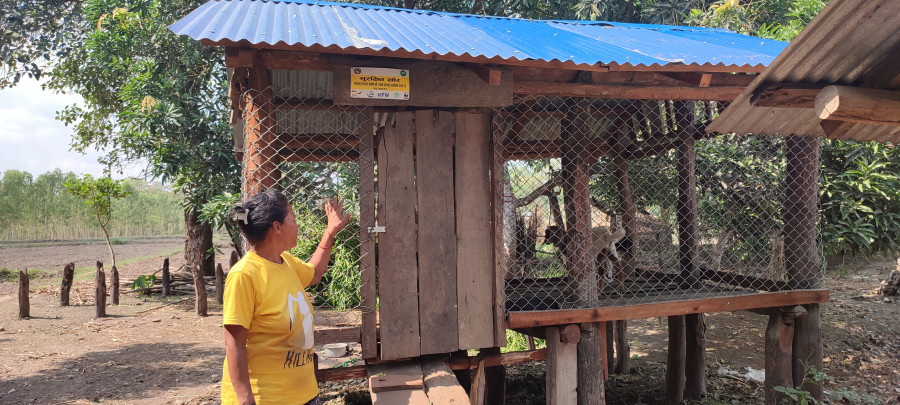National
Two national parks aid locals protect livestock from wildlife
While the rising tiger numbers in Chitwan and Parsa national parks are significant from a conservation standpoint, growing incidence of human-animal conflict in the buffer zones have threatened lives and livelihoods.
Ramesh Kumar Paudel
The buffer zone consumer committees of the Chitwan National Park and Parsa National Park have provided subsidies to goat farmers in areas surrounding the parks to help them reinforce their goat pens and prevent tiger attacks on the livestock.
Goat farmers in areas surrounding the national parks often face financial losses due to frequent tiger attacks on their livestock.
Sanisara Sedhai, a 70-year-old woman from Ayodhyapuri, Madi Municipality, lives near the forest around the Chitwan National Park’s buffer zone. She rears goats for a living and currently has 10 goats. She was constantly worried about the goats’ safety until the buffer zone consumer committee came forward to help her protect the goats by reinforcing the pens.
According to Sedhai, it costs around Rs40,000 to build a fully protected pen for ten goats. The committee provided Rs25,000 to help her build a reinforced goat pen.
“I can finally take a sigh of relief now that my goats are safe. In this area, tiger attacks on domestic animals are common; sometimes they attack even in broad daylight,” said Sedhai. “With limited income from goat farming, I could not afford to build a reinforced goat pen. The contribution made by the committee helped me a lot. The new shed is divided into two sections—one for daytime and the other for the night.”
While the increasing tiger numbers in Chitwan and Parsa national parks are significant from the conservation standpoint, the inability of the authorities to mitigate human-animal conflict in these areas puts the lives and livelihood of the residents in jeopardy.
Prakash Dhungana, chairman of the buffer zone consumer committee of Chitwan, says the park’s latest campaign to support the local community that depends on animal husbandry for livelihood is a step towards reducing the damage caused by the wild animals from the park in the local community.
Around 572 goat sheds have been reinforced using wire mesh in the buffer zone areas of Chitwan and Parsa national parks.
According to Dhungana, the Terai Arc Landscape Programme under the World Wildlife Fund has provided money to 10 buffer zone consumer committees of these two national parks, of which eight are in Chitwan and two are in Parsa.
Bichari Bista, a 55-year-old woman from Ichhanagar, Thori Rural Municipality, also lives near the buffer zone of the Chitwan National Park, and she also built a reinforced goat pen with the help of the national park. Bista said that it was very difficult for farmers like her to protect themselves and their cattle from wild animals, but not anymore.
“Now we are safe inside the house, and the goats are safe in pen,” she said.
According to the data from the Department of National Parks and Wildlife Conservation, the total number of tigers in Nepal was 121 in 2009 and the number has almost tripled to 355, according to the tiger census in April 2022.
According to Ganesh Prasad Tiwari, assistant conservation officer of the Chitwan National Park who also oversees the buffer zone areas of the park, there are 128 tigers alone in the Chitwan National Park, according to the 2022 census. In 2009, the total number of tigers in the park was 93. Chitwan National Park is known as the largest playground for tigers in Nepal.
Similarly, according to the 2022 census, the number of tigers inside the Parsa National Park has reached 41. The number was 18 in 2018. The rapid increase in the number of tigers in recent years in these two national parks, which are connected to each other, has also increased the incidence of tiger attacks on domestic animals and humans.
According to Prem Poudel, Terai Arc Landscape Programme coordinator for building and reinforcing goat sheds under the WWF, 10 buffer zone consumer committees were selected where more than 300 goats are killed by leopards and tigers every year. Chitwan and Parsa national parks also share borders with the Valmiki Tiger Reserve in Bihar, India, where the number of tigers has also increased.
"People with poor economic conditions from the tribal communities of Tharu, Bote, and Tamang mostly live nearby the forests. Most of them rear cattle. Tigers entering human settlements for food and water is normal near the areas of Chitwan, Parsa, and Valmiki," said Poudel. "Tigers usually fight with other tigers in order to protect and claim their territory, due to which weak tigers roam around human settlements in search of easy prey. Other weaker predators also go to human settlements for food due to the fear of tigers, resulting in human-animal conflict," he added. “That is why it was necessary to support the local communities to build reinforced sheds and pens for their livestock.”
According to the Chitwan National Park, around 400 to 500 locals visit the buffer zone of the park daily to collect hay and firewood or to graze cattle.




 8.12°C Kathmandu
8.12°C Kathmandu1.jpg)















